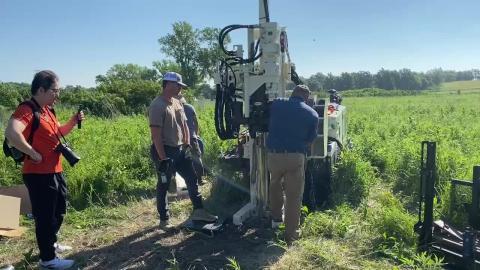By Christina Lyons, the Beatrice Daily Sun
Homestead National Historical Park workers have been working with the University of Nebraska to study the area's soil.
Homestead Resource Management Specialist Jesse Bolli said they selected Homestead as the research site and had to get special permission.
“They selected Homestead as a research site because they needed an area that had not been managed with nitrogen fertilizers,” he said. “This highlights the importance of the historic period of the Homestead as a great place for research. The restoration started in 1939 and is the second oldest restored prairie in the United States.”
University of Nebraska Water Research Scientist Dr. Arindam Malakar said they were studying how nitrogen travels through the soil.
“We are studying the journey of nitrogen,” he said. “We know that groundwater is the end of that journey, but what happens in between. This project will give us an idea.”
Malakar explained increased agricultural intensification has led to excess nitrogen inputs on soil and declined water quality in many United States regions. The US corn-belt states use large quantities of nitrogen fertilizer, and most of these regions contribute to continued pollution of local groundwater.
Under typical conditions, crops take up 47% of applied nitrogen, and the rest is lost through volatilization, run-off, and leaching. A substantial amount is leached to the vadose zone, which acts as a temporary nitrogen reservoir.
Globally, the vadose zone is estimated to store 605-1814 million tons of nitrogen as nitrate. While most vadose zone studies only measure nitrate, our studies show the widespread occurrence of both nitrate and ammonium.
The irrigation method (flood versus pivot) correlates with ammonium occurrence, suggesting that water input plays a critical underappreciated role in nitrogen fate. A wide variety of biogeochemical reactions control the occurrence of specific nitrogen species, but inaccessibility of the vadose makes it challenging to study.
This project will measure the occurrence of multiple nitrogen species beneath gravity, pivot irrigated and dryland corn using deep coring, elucidate transformation pathways between nitrogen species by comprehensive chemical analysis, and column experiments with isotope-labeled fertilizers and simulate reactive transport of nitrogen with appropriate modification of a well-developed USDA-ARS management model.
The soil samples are taken with a Geoprobe and sealed in a large plastic tube. In the lab, Malakar explained that corn would be grown in the soil and studied in different conditions.
“The new knowledge and modified model can be used as a decision-support tool by regulatory agencies to show how proposed management practices mitigate groundwater pollution,” he said. “Ultimately this work will support the development of proactive management practices to protect groundwater quality.”
Soil samples have been taken at different locations throughout Nebraska.

